2023 SUBARU BRZ air condition
[x] Cancel search: air conditionPage 1 of 432

ForewordForewordCongratulations on choosing a SUBARU vehi cle. This Owner’s
Manual has all the information necessary to keep your SUBARU in
excellent condition and to properly maintain the emission control
system for minimizing emission pollutants. We urge you to read
this manual carefully so that you may understand your vehicle and
its operation. For information not found in this Owner’s Manual,
such as details concerning repairs or adjustments, please contact
the SUBARU dealer from whom you purchased your SUBARU or
the nearest SUBARU dealer.
The information, specifications and illustrations found in this
manual are those in effect at the time of printing. SUBARU
CORPORATION reserves the right to change specifications and
designs at any time without prior notice and without incurring any
obligation to make the same or similar changes on vehicles
previously sold. This Owner’s Manu al applies to all models and
covers all equipment, including factory installed options. Some
explanations, therefore may be for equipment not installed in your
vehicle.
Please leave this manual in the vehic le at the time of resale. The next
owner will need the information found herein.
SUBARU CORPORATION, TOKYO, JAPAN“SUBARU” and the six-star cluster design are registered trademarks of SUBARU CORPORATION. Copyright 2022 SUBARU CORPORATION©
BRZ_U.book 1 ページ 2022年3月29日 火曜日 午後3時59分
Page 10 of 432

How to Use This Owner’s Manual
4■Safety SymbolYou will find a circle with a slash through it
in this manual. This symbol means “Do
not”, “Do not do this”, or “Do not let this
happen”, depending upon the context.
■ Abbreviation ListYou may find several abbreviations in this
manual. The meanings of the abbrevia-
tions are shown in the following list.
000013
Abbreviation Meaning
ABS Anti-lock brake system
A/C Air conditioner
AKI Anti knock index
ALR Automatic locking retractor
ALR/ELR Automatic locking retractor/
Emergency locking retractor
AT Automatic transmission
BSD Blind Spot Detection
DRL Daytime running light
EBD Electronic brake
force distri-
bution
ELR Emergency locking retractor
GAW Gross axle weight
GAWR Gross axle weight rating
GPS Global positioning system
GVW Gross vehicle weight
GVWR Gross vehicl e weight rating
INT Intermittent
LATCHLower anchors and tethers
for children
LCA Lane Change Assist
LED Light emitting diode
LHD Left-hand drive
LSD Limited Slip Differential
MIL Malfunction indicator light
MT Manual transmission
OBD On-board diagnostics
RAB Reverse Automatic Braking
system
RCTA Rear Cross Traffic Alert
RON Research octane number
SRH Steering Responsive Head-
light
SRS Supplemental restraint sys-
tem
TFT Thin Film Transistor
TIN Tire identification number
TPMS Tire pressure monitoring sys-
tem
TRAC Traction Control Abbreviation
Meaning
BRZ_U.book 4 ページ 2022年3月29日 火曜日 午後3時59分
Page 13 of 432
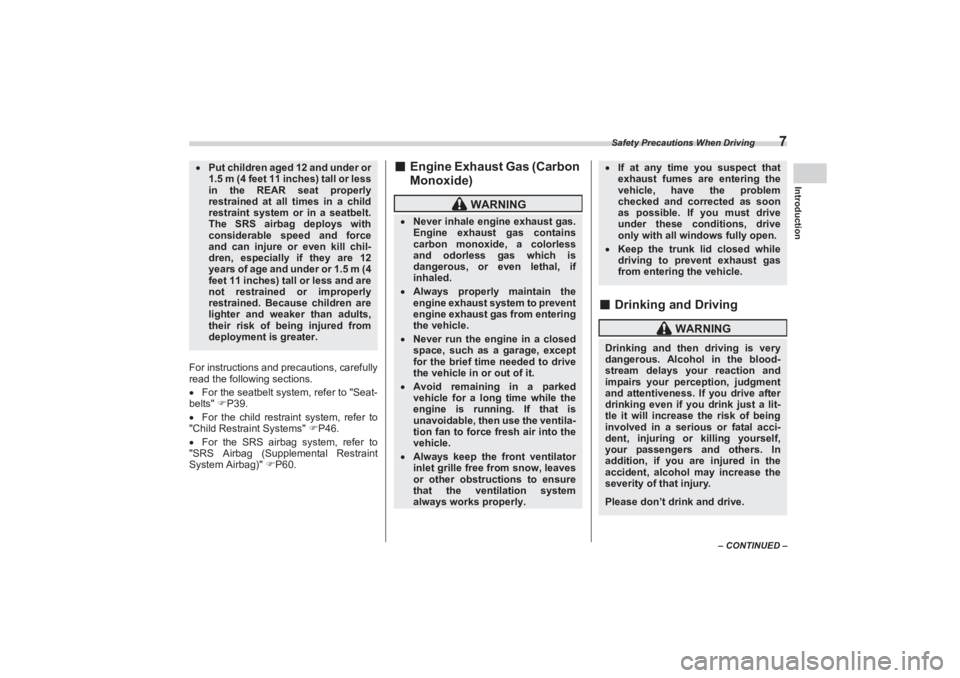
Safety Precautions When Driving
7
Introduction
– CONTINUED –
For instructions and precautions, carefully
read the following sections.
For the seatbelt system, refer to "Seat-
belts" P39.
For the child restraint system, refer to
"Child Restraint Systems" P46.
For the SRS airbag system, refer to
"SRS Airbag (Supplemental Restraint
System Airbag)" P60.
■ Engine Exhaust Gas (Carbon
Monoxide)
■Drinking and Driving
Put children aged 12 and under or
1.5 m (4 feet 11 inches) tall or less
in the REAR seat properly
restrained at all times in a child
restraint system or in a seatbelt.
The SRS airbag deploys with
considerable speed and force
and can injure or even kill chil-
dren, especially if they are 12
years of age and under or 1.5 m (4
feet 11 inches) tall or less and are
not restrained or improperly
restrained. Because children are
lighter and weaker than adults,
their risk of being injured from
deployment is greater.
WARNING
Never inhale engine exhaust gas.
Engine exhaust gas contains
carbon monoxide, a colorless
and odorless gas which is
dangerous, or even lethal, if
inhaled. Always properly maintain the
engine exhaust system to prevent
engine exhaust gas from entering
the vehicle. Never run the engine in a closed
space, such as a garage, except
for the brief time needed to drive
the vehicle in or out of it. Avoid remaining in a parked
vehicle for a long time while the
engine is running. If that is
unavoidable, then use the ventila-
tion fan to force fresh air into the
vehicle. Always keep the front ventilator
inlet grille free from snow, leaves
or other obstructions to ensure
that the ventilation system
always works properly.
If at any time you suspect that
exhaust fumes are entering the
vehicle, have the problem
checked and corrected as soon
as possible. If you must drive
under these conditions, drive
only with all windows fully open. Keep the trunk lid closed while
driving to prevent exhaust gas
from entering the vehicle.
WARNING
Drinking and then driving is very
dangerous. Alcohol in the blood-
stream delays your reaction and
impairs your perception, judgment
and attentiveness. If you drive after
drinking even if you drink just a lit-
tle it will increase the risk of being
involved in a serious or fatal acci-
dent, injuring or killing yourself,
your passengers and others. In
addition, if you are injured in the
accident, alcohol may increase the
severity of that injury.Please don’t drink and drive.
BRZ_U.book 7 ページ 2022年3月29日 火曜日 午後3時59分
Page 14 of 432
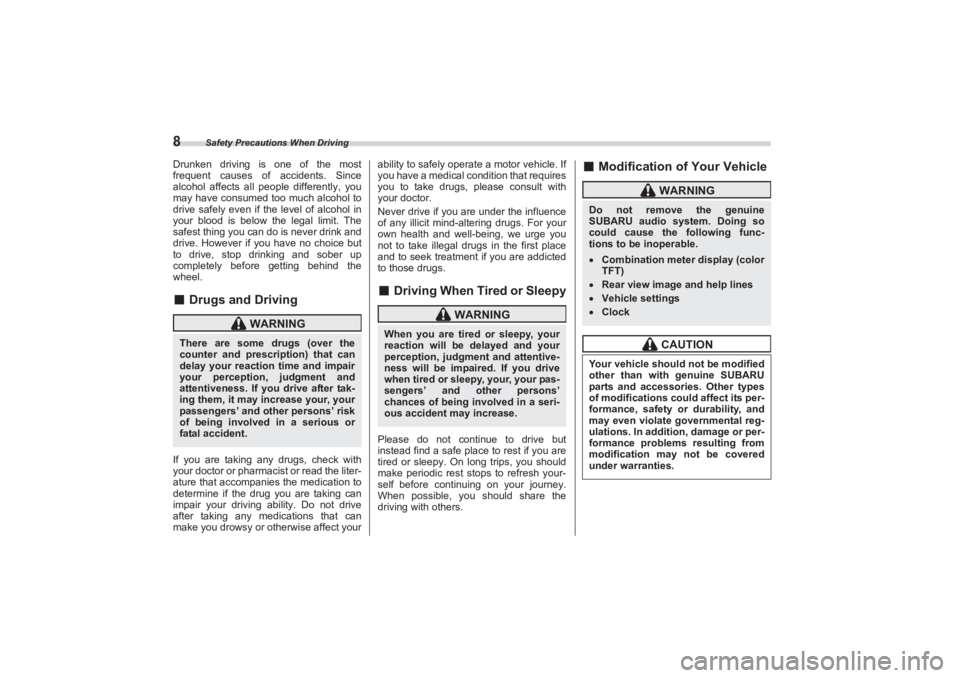
Safety Precautions When Driving
8Drunken driving is one of the most
frequent causes of accidents. Since
alcohol affects all people differently, you
may have consumed too much alcohol to
drive safely even if the level of alcohol in
your blood is below the legal limit. The
safest thing you can do is never drink and
drive. However if you have no choice but
to drive, stop drinking and sober up
completely before getting behind the
wheel.■ Drugs and DrivingIf you are taking any drugs, check with
your doctor or pharmacist or read the liter-
ature that accompanies the medication to
determine if the drug you are taking can
impair your driving ability. Do not drive
after taking any medications that can
make you drowsy or otherwise affect your ability to safely operate a motor vehicle. If
you have a medical condition that requires
you to take drugs, please consult with
your doctor.
Never drive if you are under the influence
of any illicit mind-altering drugs. For your
own health and well-being, we urge you
not to take illegal drugs in the first place
and to seek treatment if you are addicted
to those drugs.
■ Driving When Tired or SleepyPlease do not continue to drive but
instead find a safe place to rest if you are
tired or sleepy. On long trips, you should
make periodic rest stops to refresh your-
self before continuing on your journey.
When possible, you should share the
driving with others.
■ Modification of Your Vehicle
WARNING
There are some drugs (over the
counter and prescription) that can
delay your reaction time and impair
your perception, judgment and
attentiveness. If you drive after tak-
ing them, it may increase your, your
passengers’ and other persons’ risk
of being involved in a serious or
fatal accident.
WARNING
When you are tired or sleepy, your
reaction will be delayed and your
perception, judgment and attentive-
ness will be impaired. If you drive
when tired or sleepy, your, your pas-
sengers’ and other persons’
chances of being involved in a seri-
ous accident may increase.
WARNING
Do not remove the genuine
SUBARU audio system. Doing so
could cause the following func-
tions to be inoperable. Combination meter display (color
TFT) Rear view image and help linesVehicle settingsClock
CAUTION
Your vehicle should not be modified
other than with genuine SUBARU
parts and accessories. Other types
of modifications could affect its per-
formance, safety or durability, and
may even violate governmental reg-
ulations. In addition, damage or per-
formance problems resulting from
modification may not be covered
under warranties.
BRZ_U.book 8 ページ 2022年3月29日 火曜日 午後3時59分
Page 17 of 432
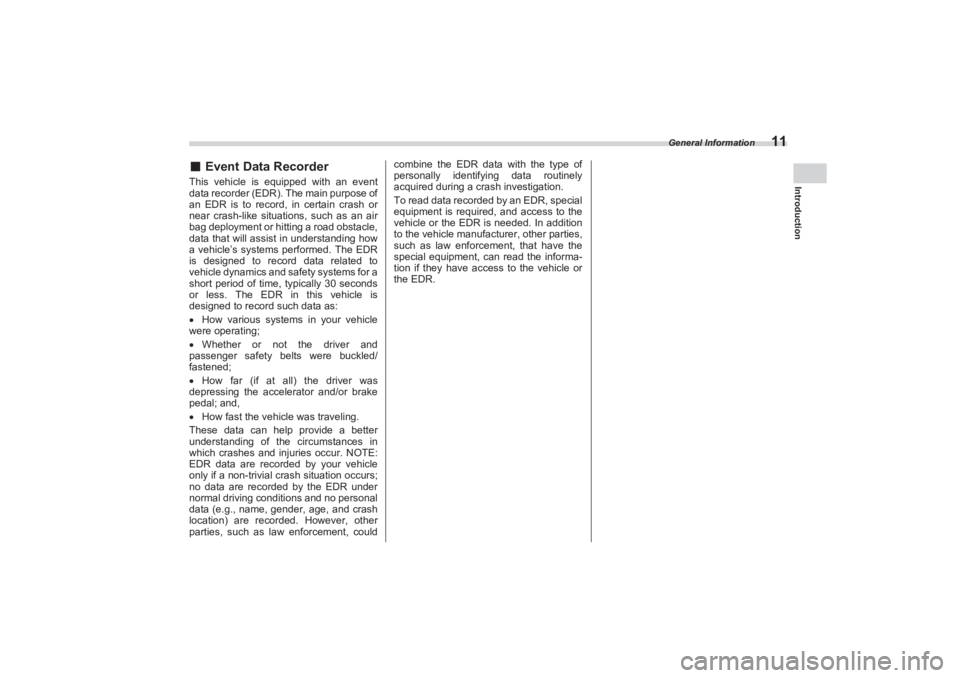
General Information
11
Introduction
■Event Data RecorderThis vehicle is equipped with an event
data recorder (EDR). The main purpose of
an EDR is to record, in certain crash or
near crash-like situations, such as an air
bag deployment or hitting a road obstacle,
data that will assist in understanding how
a vehicle’s systems performed. The EDR
is designed to record data related to
vehicle dynamics and safety systems for a
short period of time, typically 30 seconds
or less. The EDR in this vehicle is
designed to record such data as:
How various systems in your vehicle
were operating;
Whether or not the driver and
passenger safety belts were buckled/
fastened;
How far (if at all) the driver was
depressing the accelerator and/or brake
pedal; and,
How fast the vehicle was traveling.
These data can help provide a better
understanding of the circumstances in
which crashes and injuries occur. NOTE:
EDR data are recorded by your vehicle
only if a non-trivial crash situation occurs;
no data are recorded by the EDR under
normal driving conditions and no personal
data (e.g., name, gender, age, and crash
location) are recorded. However, other
parties, such as la w enforcement, could combine the EDR data with the type of
personally identifying data routinely
acquired during a crash investigation.
To read data recorded by an EDR, special
equipment is required, and access to the
vehicle or the EDR is needed. In addition
to the vehicle manufa cturer, other parties,
such as law enforcement, that have the
special equipment, can read the informa-
tion if they have access to the vehicle or
the EDR.
BRZ_U.book 11 ページ 2022年3月29日 火曜日 午後3時59分
Page 79 of 432
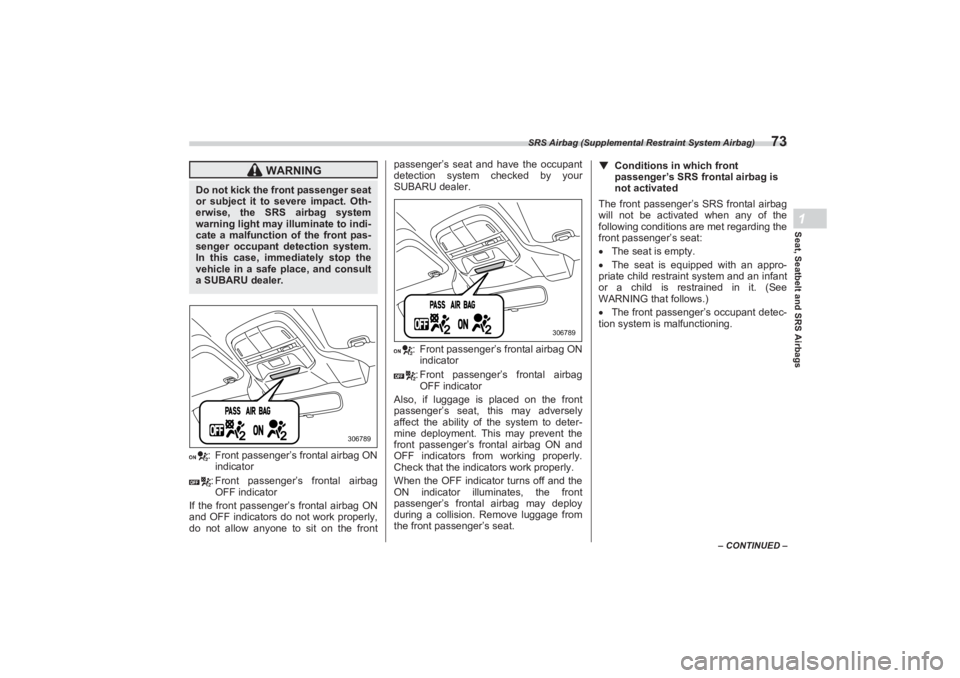
SRS Airbag (Supplemental Restraint System Airbag)
73
Seat, Seatbelt and SRS Airbags1
– CONTINUED –
: Front passenger’s frontal airbag ON
indicator
: Front passenger’s frontal airbag
OFF indicator
If the front passenger’s frontal airbag ON
and OFF indicators do not work properly,
do not allow anyone to sit on the front passenger’s seat and have the occupant
detection system checked by your
SUBARU dealer.
: Front passenger’s frontal airbag ON
indicator
: Front passenger’s frontal airbag
OFF indicator
Also, if luggage is placed on the front
passenger’s seat, this may adversely
affect the ability of the system to deter-
mine deployment. This may prevent the
front passenger’s frontal airbag ON and
OFF indicators from working properly.
Check that the indicators work properly.
When the OFF indicator turns off and the
ON indicator illuminates, the front
passenger’s frontal airbag may deploy
during a collision. Remove luggage from
the front passenger’s seat.
▼ Conditions in which front
passenger’s SRS frontal airbag is
not activatedThe front passenger’s SRS frontal airbag
will not be activated when any of the
following conditions are met regarding the
front passenger’s seat:
The seat is empty.
The seat is equipped with an appro-
priate child restrain t system and an infant
or a child is restrained in it. (See
WARNING that follows.)
The front passenger’s occupant detec-
tion system is malfunctioning.
WARNING
Do not kick the front passenger seat
or subject it to severe impact. Oth-
erwise, the SRS airbag system
warning light may illuminate to indi-
cate a malfunction of the front pas-
senger occupant detection system.
In this case, immediately stop the
vehicle in a safe pl ace, and consult
a SUBARU dealer.
306789
306789
BRZ_U.book 73 ページ 2022年3月29日 火曜日 午後3時59分
Page 80 of 432
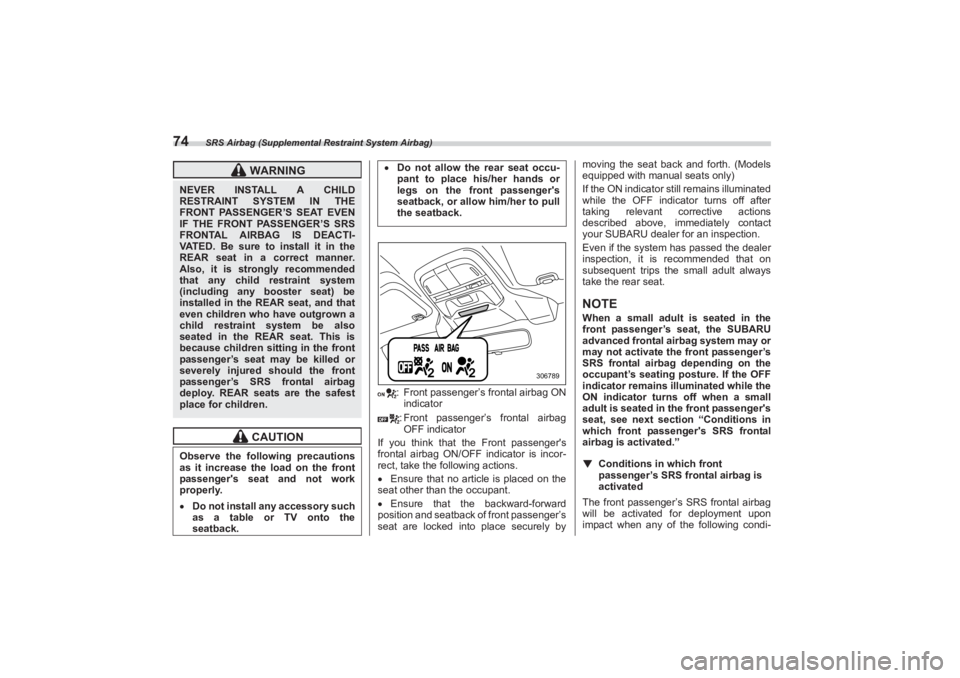
SRS Airbag (Supplemental Restraint System Airbag)
74
: Front passenger’s frontal airbag ON
indicator
: Front passenger’s frontal airbag
OFF indicator
If you think that the Front passenger's
frontal airbag ON/OFF indicator is incor-
rect, take the following actions.
Ensure that no article is placed on the
seat other than the occupant.
Ensure that the backward-forward
position and seatback of front passenger’s
seat are locked into place securely by moving the seat back and forth. (Models
equipped with manual seats only)
If the ON indicator still remains illuminated
while the OFF indicator turns off after
taking relevant corrective actions
described above, immediately contact
your SUBARU dealer for an inspection.
Even if the system has passed the dealer
inspection, it is recommended that on
subsequent trips the small adult always
take the rear seat.
NOTEWhen a small adult is seated in the
front passenger’s seat, the SUBARU
advanced frontal airbag system may or
may not activate th e front passenger’s
SRS frontal airbag depending on the
occupant’s seating posture. If the OFF
indicator remains illuminated while the
ON indicator turns off when a small
adult is seated in the front passenger's
seat, see next section “Conditions in
which front passenger's SRS frontal
airbag is activated.”▼ Conditions in which front
passenger’s SRS frontal airbag is
activatedThe front passenger’s SRS frontal airbag
will be activated for deployment upon
impact when any of the following condi-
WARNING
NEVER INSTALL A CHILD
RESTRAINT SYSTEM IN THE
FRONT PASSENGER’S SEAT EVEN
IF THE FRONT PASSENGER’S SRS
FRONTAL AIRBAG IS DEACTI-
VATED. Be sure to install it in the
REAR seat in a correct manner.
Also, it is strongly recommended
that any child restraint system
(including any booster seat) be
installed in the REAR seat, and that
even children who have outgrown a
child restraint system be also
seated in the REAR seat. This is
because children sitting in the front
passenger’s seat may be killed or
severely injured should the front
passenger’s SRS frontal airbag
deploy. REAR seats are the safest
place for children.
CAUTION
Observe the following precautions
as it increase the load on the front
passenger's seat and not work
properly. Do not install any accessory such
as a table or TV onto the
seatback.
Do not allow the rear seat occu-
pant to place his/her hands or
legs on the front passenger's
seatback, or allow him/her to pull
the seatback.
306789
BRZ_U.book 74 ページ 2022年3月29日 火曜日 午後3時59分
Page 82 of 432

SRS Airbag (Supplemental Restraint System Airbag)
76▼Operation
101586
A
B
1
2
A) Driver’s side
B) Passenger’s side
1) SRS AIRBAGs deploy as soon as a
collision occurs.
2) After deployment, SRS AIRBAGs start
to deflate immediately so that the
driver’s vision is not obstructed.The SRS airbags can function only when
the ignition switch is in the “ON” position.
The SUBARU advanced frontal airbag
system is designed to determine the acti-
vation or deactivation condition of the front
passenger’s SRS frontal airbag
depending on the characteristic of item(s)
or person on the front passenger’s seat
monitored by the front passenger’s occu-
pant detection sensors. For this reason,
only the driver’s SRS frontal airbag may
deploy in the event of a collision, but this
does not mean failure of the system.
If the following sensors detect a predeter-
mined amount of force during a frontal
collision, the control module sends signals
to the airbag module(s) (only driver’s
module or both driver’s and front
passenger’s modules) instructing the
module(s) to inflate the SRS frontal
airbag(s).
BRZ_U.book 76 ページ 2022年3月29日 火曜日 午後3時59分